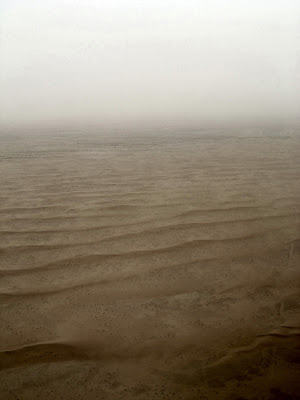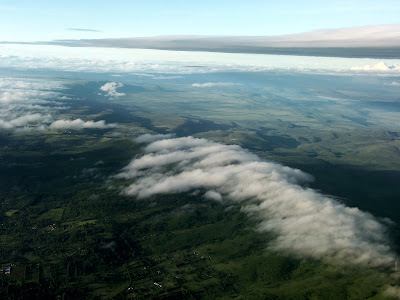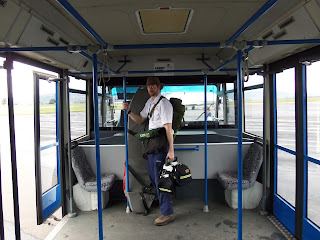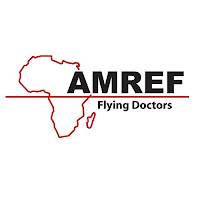.JPG) This weekend I was given the call to attend to a sick
climber who was on his way down from summiting Mount Kilimanjaro. He seemed to
be suffering badly from altitude sickness, but with no medical personnel on his
trek it was difficult to get an idea of his severity. Given that these
retrievals require a helicopter with extremely limited space and limited on
weight, we can take very limited equipment. Also with it getting later in the
day, we were getting extremely limited on time. As Tanzania warms up throughout
the day, cloud tends to roll up Kili towards the afternoon and so the
helicopters can’t get up there.
This weekend I was given the call to attend to a sick
climber who was on his way down from summiting Mount Kilimanjaro. He seemed to
be suffering badly from altitude sickness, but with no medical personnel on his
trek it was difficult to get an idea of his severity. Given that these
retrievals require a helicopter with extremely limited space and limited on
weight, we can take very limited equipment. Also with it getting later in the
day, we were getting extremely limited on time. As Tanzania warms up throughout
the day, cloud tends to roll up Kili towards the afternoon and so the
helicopters can’t get up there..JPG) Kili has been getting a bad reputation in the last few years
for climbers becoming extremely sick up there and a handful of deaths each year.
I’ve never climbed it but I know that most people consider it a simple trek and therefore not worthy of the respect such an altitude deserves. It’s the kind of
charity event that a city executive might jog around the park a couple of time
to train for and then bumble his way up and down (with a small army of porters
I might add). So why are people running into problems? I am told that the medic
often doesn’t summit because they are looking after the clients who fall by the
wayside. Having worked alongside a lot of expedition doctors who have done it,
the problems are multifactorial:-
Kili has been getting a bad reputation in the last few years
for climbers becoming extremely sick up there and a handful of deaths each year.
I’ve never climbed it but I know that most people consider it a simple trek and therefore not worthy of the respect such an altitude deserves. It’s the kind of
charity event that a city executive might jog around the park a couple of time
to train for and then bumble his way up and down (with a small army of porters
I might add). So why are people running into problems? I am told that the medic
often doesn’t summit because they are looking after the clients who fall by the
wayside. Having worked alongside a lot of expedition doctors who have done it,
the problems are multifactorial:-.JPG) 1)
The ascent is extremely quick. Most groups will dash
for the summit from 4600m to 5895m in one day. The safe recommended ascent rate
is only 300m per day in order to acclimatise. The route is fairly
straightforward so it can be done pretty fast. My friends tell me to expect at
least 80% of the clients to have signs of moderate altitude sickness by the
summit.
1)
The ascent is extremely quick. Most groups will dash
for the summit from 4600m to 5895m in one day. The safe recommended ascent rate
is only 300m per day in order to acclimatise. The route is fairly
straightforward so it can be done pretty fast. My friends tell me to expect at
least 80% of the clients to have signs of moderate altitude sickness by the
summit.
2)
The group mentality. People always explain away
their symptoms by dehydration, a change in diet, bright sunlight causing
headaches etc etc. So they press on despite often quite severe symptoms. With
mild symptoms you can stop and acclimatise and you will be fine. But if you
ascend you could be in all sorts of problems. However we don’t want to look
weak in front of the group, we don’t want to hold people up and the guides want
to get you to the top.
3)
A lack of
appreciation or understanding of the risks of altitude sickness. Most of the
people I speak to
believe that if you are strong, fit and fast you are less
likely to get AMS. Wrong. You are more likely to run into problems. Slow and
steady types tend to fare much better. And probably more importantly, it can
happen to anyone.
4)
Genetically, unlike the indigenous people of the
Himalaya or the Andes, Africans are no better at coping with altitude than you
or I. Also they cope poorly with the cold and are rarely equipped properly. If
it weren’t for a load of strange white folks insistent on climbing up things,
it’s rather unlikely they would have bothered. As Peter, my friend from South
Sudan said at dinner “What is with you Mzungus (white guys)? Why climb to the
top of mountains making your life difficult for no reason?” So the porters,
keen to make money, push themselves extremely
hard and frequently run into problems,
especially the new ones.
5)
Then there is the concurrent common issue of
trauma. Kili is non-technical, i.e. ropes, crampons, harnesses etc not required
but if you are staggering around with poor coordination due to a mix of
fatigue, dehydration and AMS you can easily lose your footing and you can
imagine the rest.
So what is Acute Mountain
Sickness? I’ll be brief but it’s a fascinating subject. It’s basically a
syndrome caused by prolonged exposure and physical activity in a low pressure
atmosphere. At altitude there is less of all the atmospheric gases, not just
oxygen but you feel the effects of the hypoxia (not enough oxygen) very
quickly. To demonstrate, if I immediately took you to the top of Everest from
sea level you would have a couple of minutes of useful consciousness then pass
out and die if we didn’t get you some O2. Hence why airplane stewardesses say
“In the event of cabin depressurisation, oxygen masks will fall from the panel
above your heads. Make sure you put your own mask on before attending to your
children.” (Children are basically rubbish in a crisis) But we climb mountains
very slowly and acclimatise. Over minutes, we breathe faster. Over hours, our
kidneys adjust things to cope with the changes in blood alkalinity. Over days our
haemoglobin changes to deliver oxygen at lower atmospheric levels. Over weeks,
we start producing more red blood cells to cope with less O2 and over
generations we recruit/alter genes that allow this process to work more
efficiently.
 |
| My own oxygen saturations were 77% at Everest BC |
Most people will have some
symptoms above 3500m and eventually be able to comfortably tolerate levels of
hypoxia which would make them pass out at sea level. See picture right
. The symptoms
include headaches, nausea, fatigue which are all pretty non-specific and common
for lots of people who has just been a few days in new country, so they are
easy to brush off. I’m not sure of what current research says but it used to be
thought of as slight brain swelling and the direct precursor to its far uglier grown
up sister, full blown cerebral oedema where the swelling gets out of control.
These patients start stumbling about and becoming more and more confused until
they slip into a coma.
Then there is ‘pulmonary oedema’ which
is basically drowning in your own tissue fluid as it secretes out into your
lungs. It’s not clear why one person develops this and the next doesn’t. The
best way of understanding this is as having overly sensitive blood vessels in
your lungs which constrict in response to the drop in oxygen. This isn’t weird,
they are meant to do this. Sitting here writing this I use about 600ml per
breath even though I have about a 7.5litre lung capacity. So the 7 litres of
lung tissue I’m not using gets shut down (the vessels constrict) when I don’t
need it. And it’s that reaction that is thought to go a bit haywire in reaction
to the low O2 levels at altitude. Constricting your lung’s vessels is fine when
you don’t need them, but when you do (like when you are starved of oxygen
climbing a mountain for example) you become very short of breath, the right
side of your heart gets strained and fluid and even blood starts getting forced
out of your blood vessels into your lungs. Which then further reduces available
oxygen making the problem worse and you spiral the plughole as your lungs fill up.
Not a nice way to go. I remember evacuating a poor girl from Gokyo Ri in Nepal,
who went from bounding up the rocks like a mountain goat and two days later
couldn’t walk across the room.
 Well the best treatment for all
of them is descent, more oxygen or more pressure. Any of these will sort them
out in the vast majority of cases. Other treatments can help, for example
Diamox, steroids, nifedipine and even Viagra (yes Viagra, but an erection in a
climbing harness is never fun). But what do you do if you are really sick and
you can’t descend, you have no O2 bottles and no portable hyperbaric chamber?
You are screwed frankly. Or someone comes along in a helicopter and saves you.
Weather permitting of course.
Well the best treatment for all
of them is descent, more oxygen or more pressure. Any of these will sort them
out in the vast majority of cases. Other treatments can help, for example
Diamox, steroids, nifedipine and even Viagra (yes Viagra, but an erection in a
climbing harness is never fun). But what do you do if you are really sick and
you can’t descend, you have no O2 bottles and no portable hyperbaric chamber?
You are screwed frankly. Or someone comes along in a helicopter and saves you.
Weather permitting of course.
So back to the evacuation. With
this scanty information we set off across the stunning plains of southern Kenya
towards Tanzania and the looming cone of Mount Kilimanjaro in the distance. As
we bombed along at about 2000ft we passed over giraffes, ostriches, elephants
and seemed to scare the crap out of a heard of wildebeest. In between the fauna
sightings we discussed our plan for the evacuation. With the cloud thickening
we decided the best plan was a ‘scoop and run’. Chuck him on the stretcher, fix
the monitoring, get him on oxygen and get off the mountain. We were all agreed;
whatever his status, he was far better off about 1000m further down.
As we
approached Kili we saw our window of opportunity was narrow if it hadn’t
already passed. Kim our pilot skilfully wound his way around the clouds to the
western slopes and climbed through above the clouds. More and more of the
impressive peak loomed into view and we could soon see snow and the summit. We
passed over one camp fairly low which raised a few cameras from the trekkers
and headed higher towards the given coordinates.
The guides and patient were close
to the helipad and Kim pointed out the cloud below us. He told us that “It’s
marching up the hill pretty bloody quick. I can give you 2 minutes to assess
the patient.” Unreasonable demands from the stressed; it was like being
in the Emergency Department again! Luckily the patient had improved and could
walk. We basically grabbed him with the blades roaring above our heads and
chucked him on the stretcher. Monitoring and O2 on, all back in the helicopter
(after I managed to sneak a quick shot) and we took off. We had to fly higher
up the mountain and Kim displayed some nifty piloting around the slopes until
we were above the cloud and looking for a gap to descend through.
The patient improved and we all
enjoyed a beautiful flight back to Wilson with the gentle orange hue
from the low
sun projecting long shadows across the plains. This really is a tough job.




.JPG)


+-+Copy.JPG)

.JPG)

.JPG)





































